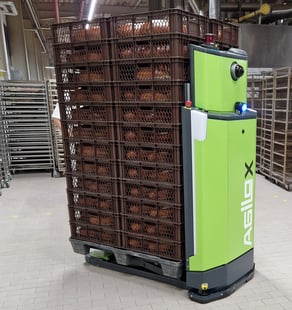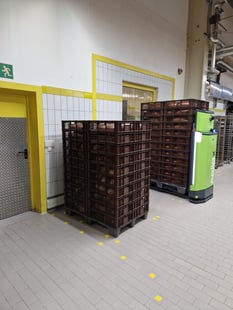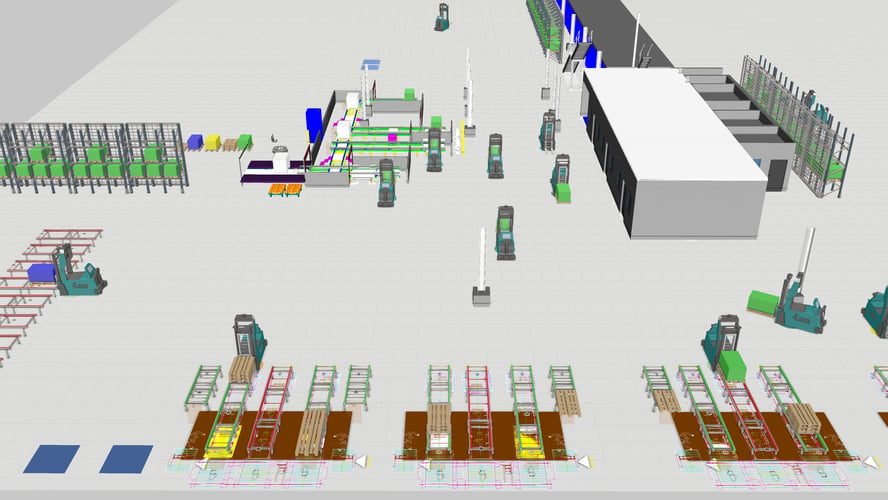.png?width=950&name=SCIO%20Website%20Featurebild%201910x1000%20(9).png)
In times of fluctuating demand, increasing delivery frequency, as well as bottlenecks and the need to comply with the most stringent safety requirements, automation in the food sector has taken on enormous importance – this was especially true during the pandemic. Food companies were still at the start of their journey towards creating a smart factory just a few short years ago, but now transformation has progressively come into this industry as well. So, let’s say we’ve taken the first step towards developing a smart factory concept, but where do we go from here?
Manufacturing companies undergoing digital transformation is no longer a pipedream, it’s now an urgent priority to ensure that they remain successful. The next generation of industry is always characterized by a set of trends. You need to integrate these into your own processes to prove yourself on the market over the long term. We took a look at the most important current intralogistics trends in the food industry with Sales Manager Jan Schumacher from SCIO product brand MFI.
Trend 1: Automated storage systems in the frozen food sectorAs the central link between food production and trade, frozen food storage plays a crucial role. Due to numerous factors driven by the pandemic, the trend of increasing frozen food production rapidly gathered pace, meaning that frozen food warehouses became even more significant. This is just one of many reasons, including:
• Supply shortages and isolation• Home office and remote work
• Skilled labor shortages (Producing fresh products during the day shift is more difficult, e.g in bakery industry)
A frozen food warehouse must be designed to ensure efficiency from the very start at the planning stage to guarantee that it will remain economically viable over the long-term. To do this, the focus needs to be on the structure, the logistical setup and degree of automation. SCIO's corporate brand MFI offers a solution to meet the ever-increasing list of requirements with its customized deep-freeze warehouses. How? "The operative word here is ample storage density," said Jan Schumacher.
One example of this is the multi-flex deep-freeze warehouse built by MFI for their major customer Coppenrath und Wiese. By using carriers, shuttles and an integrated control system, the intralogistics experts were able to achieve a high throughput rate while simultaneously keeping space requirements to a minimum and making significant energy savings. In July 2021, MFI was able to implement Germany's first multi-flex warehouse for the deep-freeze sector at -25 degrees Celsius.
Trend 2: Comprehensive supply chain automation
The concept of "efficient logistics in the supply chain" has also taken on a whole new level of significance for companies in recent years as a result of the recent war and pandemic. Volume, cost and time pressures have increased enormously, not least due to the rapidly growing demand for frozen and shelf-stable food. As a result, F&B companies are turning to supply chain automation more and more often to improve the efficiency and effectiveness of their supply chains. By using automated tools and applications, processes such as order and inventory management, transportation and storage can be optimized to a significant extent. One of the most popular solutions for supply chain automation is warehouse management software (WMS), which helps companies keep track of their inventory levels and to prevent:
• Shortages
• Food waste
• Multiple orders
• Loss of quality
MFI has been developing special software solutions for intralogistics for almost 30 years. The latest innovation is EDY 3.0, this builds on previous developments in their modular intralogistics software, which consists of the core modules warehouse management and material flow systems. EDY 3.0 is extremely flexible and one of the most stable software solutions on the market. MFI has already built up an enviable client base of more than 50 companies that have put their logistics systems into operation with EDY. Their major customer Delta Pronatura is also among them.
Trend 3: Collaborative intralogistics
Alongside the challenges mentioned above, such as cost and time pressure, one specific problem is of particular concern to manufacturing companies in the food sector, Jan Schumacher (MFI) was happy to explain: "The biggest issue we’re facing at the moment is the lack of employeeson the production line. This type of shortage has far-reaching consequences, such as reduced production as a whole, so this means that companies can only continue to deliver and prove themselves on the market if they automate in a very specific way."
As the saying goes, necessity is the mother of invention, and businesses across the country continually striving to solve problems has led to collaborative solutions such as cobots or automated guided vehicles (AGVs) being used in the food industry more and more regularly to carry out repetitive and hazardous work around the clock. The industry can certainly benefit from using automated guided vehicle in a myriad of ways, such as:
• Increased capacity:
Automated material handling while compensating for labor shortages
• Improved safety at work:
Reducing the risk of accident/injuries compared to manual transports
• Flexible customization:
Seamless integration into production processes and the ability to rapidly adapt to changes in demand
• Improvement in product quality:
Improved precision and accuracy in transporting materials keeps errors to a minimum
MFI is also fully committed to making the benefits of these modern technologies available to the food industry. Plans are being drawn up to use an AGV in a current project, and it will soon be able to transport a customer’s bread trolleys from the ovens to the picking area autonomously, without the need for any additional route infrastructure in the production rooms. Thanks to this integration, in terms of the total distance traveled each day, the AGV is able to do the same amount of work as an additional employee, which essentially eliminates the skilled workers shortage issue. This also means that employees can work more efficiently where they are actually needed. Menial jobs will be a thing of the past.
 |
 |
Trend 4: Sustainable logistics
"Sustainability in the food industry is without doubt one of the most pressing issues when talking about the future. If you want to secure your competitiveness as a company, you have to think outside the box. It's not just about keeping risks to a minimum the most important thing is using sustainability as a driver for quality and innovation," Jan Schumacher explained.
This is a trend that can be explored in several ways:
• Scalable systems
• Energy saving/recovery
• Efficient warehouse/process planning
To name just a few.
These approaches sound good in theory, but what about implementing them in practice?
What’s possible in terms of sustainable logistics has been demonstrated by our intralogistics experts at MFI now that they've built a customized high-bay warehouse for customer Vitakraft. Sophisticated logistics ensures that logistics work can be centralized, and goods from external suppliers and products from the company's own production line can be stored and retrieved autonomously. Factory traffic to the external warehouses has been significantly reduced, resulting in saving approximately 12,000 liters of diesel each year. In addition to these savings, the new high-bay warehouse it is also fully sustainable due to its state-of-the-art technology. For example, the energy for the warehouse is sustainably sourced from a fuel cell. This not only reduces CO2 emissions, but also complies with modern fire safety regulations.
The centralized logistics and sustainable energy supply system not only makes work processes easier, it also conserves resources and is kind to the environment.
Learn more about the innovative intralogistics solutions here.
Or visit us at our booth (ES51 ,EAST Entrance ) at LogiMAT 2023! Together with our brands MFI GmbH, 4am Robotics, Schiller Automatisierungstechnik GmbH, Modumaq Technologic Solutions as well as PrintoLUX GmbH we will present you our comprehensive intralogistics portfolio.





















.png?height=500&name=SCIO%20Website%20Featurebild%201910x1000%20(8).png)